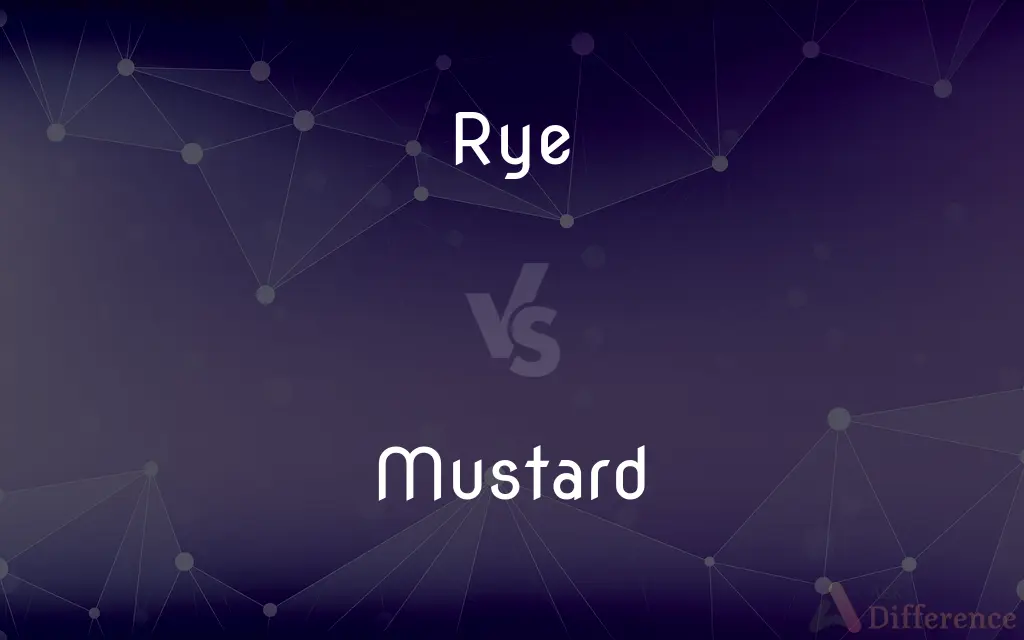Rye vs. Mustard — What's the Difference?
By Maham Liaqat & Urooj Arif — Updated on April 9, 2024
Rye is a cereal grain known for its hardiness, while mustard is a condiment derived from the seeds of the mustard plant.

Difference Between Rye and Mustard
Table of Contents
ADVERTISEMENT
Key Differences
Rye, a member of the wheat family, is primarily grown for its grain, which is used in making rye bread, whiskey, and animal feed. Its ability to thrive in poor soils makes it a valuable crop in harsh climates. Mustard, on the other hand, refers to the seeds of the mustard plant and the condiment made from these seeds. It is used to enhance the flavor of foods and comes in various forms, including yellow, brown, and black mustard seeds.
While rye is valued for its grain, contributing significantly to the culinary and beverage industries, mustard seeds are prized for their use in cooking, medicine, and as a spice. Rye grain is processed into flour for baking or distilled for alcoholic beverages, whereas mustard seeds are ground into powder, mixed with liquids like water, vinegar, or wine, and used as a condiment or spice.
Rye is sown in the fall and harvested in the early summer, thriving in cooler climates. Mustard plants, versatile in their growing conditions, can be found in temperate regions across the globe. The cultivation of rye is extensive, covering large fields, while mustard plants are often grown in smaller plots or gardens.
Environmental impacts of cultivating rye include soil erosion control and providing a winter cover crop to protect the land. Mustard cultivation, on the other hand, is noted for its benefits in crop rotation, acting as a biofumigant to suppress weeds and soil-borne diseases.
The economic value of rye and mustard varies by their applications. Rye is a staple in certain diets and has a steady market in the food and beverage sector. Mustard seeds and mustard condiment have a global market, enhancing the flavors of various cuisines and serving as an essential ingredient in many dishes.
ADVERTISEMENT
Comparison Chart
Type
Cereal Grain
Condiment/Plant
Primary Use
Bread, whiskey, animal feed
Flavoring food
Cultivation
Thrives in poor soil, cooler climates
Grown in temperate regions
Harvest Season
Early summer
Varies, depending on the climate
Environmental Impact
Soil erosion control, cover crop
Biofumigant, enhances crop rotation
Economic Value
Food and beverage industry staple
Flavor enhancement in cuisines
Compare with Definitions
Rye
Grows well in poor soils and harsh climates.
The farmer planted rye as it's known for its hardiness against cold weather.
Mustard
Acts as a biofumigant in crop rotations.
Planting mustard helps control nematodes and weeds in the garden.
Rye
Harvested in early summer.
They started harvesting the rye in early June, just as the weather warmed.
Mustard
Seeds used to make a popular condiment for flavoring food.
Mustard adds a spicy kick to sandwiches and dressings.
Rye
A cereal grain used for making bread, whiskey, and animal feed.
Rye bread is known for its dense, dark, and flavorful profile.
Mustard
Grown in temperate regions worldwide.
Mustard fields, blooming with yellow flowers, are a common sight in spring.
Rye
Serves as a cover crop to prevent soil erosion.
The field was sown with rye to protect the soil over winter.
Mustard
Comes in several varieties, including yellow, brown, and black.
Black mustard seeds are used in Indian cooking for their intense flavor.
Rye
A staple grain in various cultures, especially in Eastern Europe.
Rye vodka is a traditional drink in many Eastern European countries.
Mustard
Has medicinal properties and is used in traditional remedies.
Mustard plasters are a time-honored remedy for chest congestion.
Rye
Rye (Secale cereale) is a grass grown extensively as a grain, a cover crop and a forage crop. It is a member of the wheat tribe (Triticeae) and is closely related to both wheat (Triticum) and barley (genus Hordeum).
Mustard
A hot-tasting yellow or brown paste made from the crushed seeds of certain plants, typically eaten with meat or used as a cooking ingredient
Dijon mustard
Mustard sauce
Rye
A cereal grass (Secale cereale) of cool climates, widely cultivated for its grain.
Mustard
The yellow-flowered Eurasian plant of the cabbage family whose seeds are used to make mustard.
Rye
The grain of this plant, ground into flour or used in making whiskey and for livestock feed.
Mustard
A brownish yellow colour
A mustard sweater
Rye
Rye bread.
Mustard
Any of various Eurasian plants of the mustard family, especially white mustard, Indian mustard, and black mustard, which are cultivated for their pungent seeds and edible leaves.
Rye
Whiskey made from the grains of this plant.
Mustard
A condiment made from the powdered seeds of certain of these plants.
Rye
A Romani man.
Mustard
A member of the mustard family.
Rye
A grain used extensively in Europe for making bread, beer, and (now generally) for animal fodder.
Mustard
A dark yellow to light olive brown.
Rye
The grass Secale cereale from which the grain is obtained.
Mustard
Any of a group of toxic organic compounds that include mustard gas and the nitrogen mustards.
Rye
Rye bread.
Mustard
A plant of certain species of the genus Brassica, or of related genera (especially Sinapis alba, in the family Brassicaceae, with yellow flowers, and linear seed pods).
Rye
Rye whiskey.
Mustard
Powder or paste made from seeds of the mustard plant, and used as a condiment or a spice.
When the waitress brought the food, I asked whether she had any Dijon mustard.
Rye
A drink of rye.
Mustard
The leaves of the mustard plant, used as a salad.
Mustard and cress sandwiches.
Rye
Caraway (from the mistaken assumption that the whole seeds, often used to season rye bread, are the rye itself)
Mustard
Dark yellow colour, the colour of mustard.
Rye
Ryegrass, any of the species of Lolium.
Mustard
One of a family of vesicants containing one or more 2-chloroethyl (C2H4Cl) groups, commonly used in chemical warfare and cancer chemotherapy.
Rye
A disease of hawks.
Mustard
The tomalley of a crab, which resembles the condiment.
Rye
A grain yielded by a hardy cereal grass (Secale cereale), closely allied to wheat; also, the plant itself. Rye constitutes a large portion of the breadstuff used by man.
Mustard
Of a dark yellow colour.
Rye
A disease in a hawk.
Mustard
The name of several cruciferous plants of the genus Brassica (formerly Sinapis), as white mustard (Brassica alba), black mustard (Brassica Nigra), wild mustard or charlock (Brassica Sinapistrum).
Rye
The seed of the cereal grass
Mustard
A powder or a paste made from the seeds of black or white mustard, used as a condiment and a rubefacient. Taken internally it is stimulant and diuretic, and in large doses is emetic.
Rye
Hardy annual cereal grass widely cultivated in northern Europe where its grain is the chief ingredient of black bread and in North America for forage and soil improvement
Mustard
Any of several cruciferous plants of the genus Brassica
Rye
Whiskey distilled from rye or rye and malt
Mustard
Pungent powder or paste prepared from ground mustard seeds
Mustard
Leaves eaten as cooked greens
Common Curiosities
What is rye used for?
Rye is used for making bread, whiskey, and as animal feed.
How does mustard enhance food?
Mustard adds flavor, ranging from spicy to tangy, to various dishes.
Can rye grow in poor soil?
Yes, rye can thrive in poor soils and is known for its hardiness.
What are the different types of mustard seeds?
Mustard seeds come in yellow, brown, and black varieties, each with unique flavors.
How are mustard seeds used in cooking?
Mustard seeds are ground into powder, used as a spice, or mixed with liquids to make mustard sauce.
What climates are suitable for growing rye?
Rye prefers cooler climates and can even thrive in less fertile soils.
What makes mustard a popular condiment?
Its versatility and range of flavors make mustard a popular addition to many dishes worldwide.
What is the economic importance of rye?
Rye is vital for the food and beverage industry, especially in regions where it's a dietary staple.
Why is rye considered environmentally friendly?
Rye acts as a cover crop, preventing soil erosion and improving soil health.
How does mustard contribute to crop rotation?
Mustard plants can act as biofumigants, naturally deterring pests and diseases.
What alcoholic beverages are made from rye?
Whiskey and some types of vodka are distilled from rye grain.
Can mustard seeds be eaten whole?
Yes, but they are typically ground or used as a spice in cooking for their pungent flavor.
What are the benefits of growing mustard in a garden?
Mustard can suppress weeds and soil-borne diseases, improving garden health.
Is rye grain healthy?
Yes, rye grain is rich in fiber, vitamins, and minerals, offering various health benefits.
Are there any health concerns associated with rye or mustard?
While both are generally healthy, individuals with specific allergies or dietary restrictions should consume them cautiously.
Share Your Discovery

Previous Comparison
Aval vs. Ava
Next Comparison
Supplement vs. SupplementationAuthor Spotlight
Written by
Maham LiaqatCo-written by
Urooj ArifUrooj is a skilled content writer at Ask Difference, known for her exceptional ability to simplify complex topics into engaging and informative content. With a passion for research and a flair for clear, concise writing, she consistently delivers articles that resonate with our diverse audience.
















































